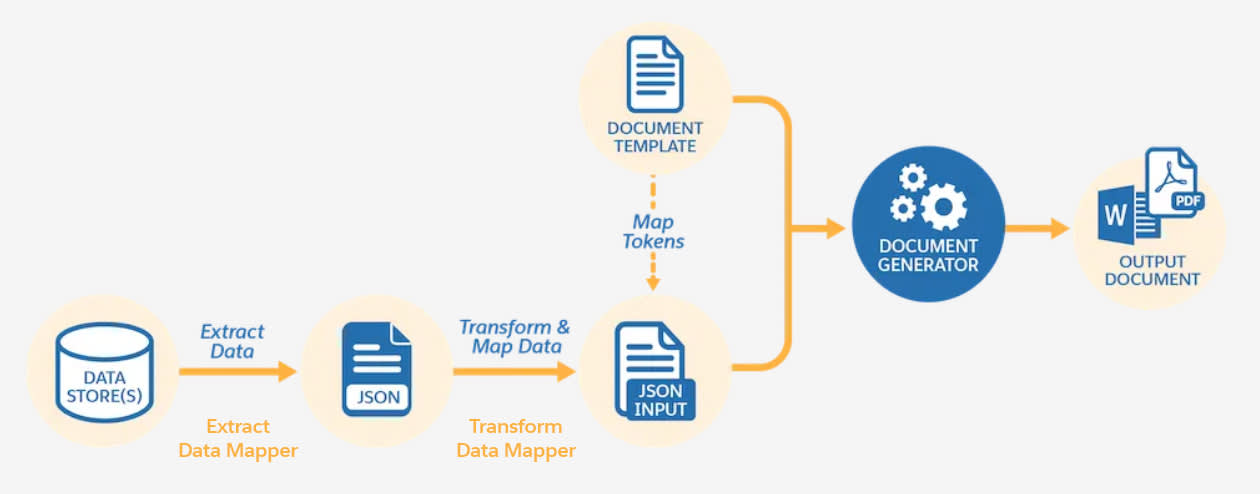OmniStudio Document Generation の詳細を知る
学習の目的
この単元を完了すると、次のことができるようになります。
- OmniStudio Document Generation の機能を挙げる。
- Document Template Designer とデータトークンについて説明する。
- Data Mapper と OmniScript の用途について説明する。
Document Template Designer とデータトークンについて知る
OmniStudio Document Generation を使用して、Candace のような営業担当は次のことを実行できます。
- Document Template Designer ツールで .docx 形式と .pptx 形式のドキュメントテンプレートを作成する。
- テンプレートでデータトークン、条件ロジック、表を使用する。
- JSON (JavaScript オブジェクト表記) を使用して内部データと外部データを抽出してマッピングする。
- さまざまなソースやプロセスを使用してドキュメントを生成する。
では、機能について細かく見ていきましょう。
Document Template Designer
ドキュメントテンプレートは、生成されるドキュメントの構造、コンテンツ、形式を定義します。Document Template Designer は、Salesforce 組織でドキュメントテンプレートを作成するために使用するツールです。表、段落、列、画像など、書式設定されたテキストを含む Microsoft Word または PowerPoint ドキュメントを作成し、 そのドキュメントを新しいテンプレートのベースとして使用できます。
Document Template Designer の [Start New Template (新規テンプレートを開始)] 画面で、テンプレート設定を定義し、.docx ファイルまたは .pptx ファイルをアップロードしてドキュメントテンプレートを作成します。
![[Template Settings (テンプレート設定)] セクションと [Attach File (ファイル添付)] セクションが表示されている Document Template Designer の [Start New Template (新規テンプレートを開始)] 画面。](https://res.cloudinary.com/hy4kyit2a/f_auto,fl_lossy,q_70/learn/modules/omnistudio-document-generation-foundations/dive-into-document-generation-capabilities-unit-2/images/ja-JP/b7f00ec22a0ec48f2bf07b1e45d7b587_kix.wb1xko71dgyu.png)
データトークン
Candace は、ときには複雑なドキュメントを作成する必要があります。そのようなドキュメントの場合、テンプレートにデータトークンを挿入して特定の機能を実行することができます。さまざまなトークンの種別を理解しておきましょう。
トークン種別 |
関数 |
|---|---|
変数 |
ドキュメントテンプレートに JSON 要素として渡される変数の値を表示します。 |
繰り返しコンテンツ |
コンテンツセクション (商品のリストなど) を繰り返します。 |
条件ロジック |
Boolean 条件をチェックして、特定の条件が満たされた場合にコンテンツを表示します。コンテンツは表形式で表示できます。 |
画像 |
生成されたドキュメントに動的画像を挿入します。 |
リッチテキスト |
生成されたドキュメントにリッチテキストコンテンツを挿入します。 |
ハイパーリンク |
生成されたドキュメントに動的 URL を挿入します。 |
JSON を使用したデータマッピング
OmniStudio ドキュメント生成には Data Mapper と OmniScript が含まれています。Data Mapper とはデータの取得、変換、更新を行う構成可能なサービスで、OmniScript はビジネスプロセスを完了するためのガイド付きパスをユーザーに提供します。
JSON ベースのドキュメント生成データフローとマッピングのしくみを見ていきましょう。
Salesforce 組織または外部データベースのデータをドキュメントに入力できます。そのため、テンプレートを作成するときに、テンプレートを任意のソースからの JSON インプットデータと関連付けることができます。たとえば、テンプレートは OmniScript の Data Mapper Extraction Step のインプット JSON データ、またはユーザーが直接入力する OmniScript のデータを受け入れることができます。Document Template Designer の [Start New Template (新規テンプレートを開始)] 画面の [Token Mapping Method (トークン対応付け方法)] 設定によってテンプレートのトークンを入力する方法が決まります。OmniDataTransform またはカスタムクラスを使用できます。ドキュメント生成機能は、ドキュメントテンプレートと JSON データを使用して PDF または Microsoft Word の形式で出力ドキュメントを作成します。

OmniStudio アーキテクチャについての詳細は「OmniStudio アーキテクチャ」モジュールを参照してください。
クライアント側またはサーバー側の処理
クライアント側とサーバー側のサンプル OmniScript を使用してドキュメントを生成できます。
OmniScript によるガイドに従って、ドキュメントの生成に必要な各ステップを実行できます。サンプルのクライアント側 OmniScript の場合、次のステップがあります。
- オブジェクト ID を入力する
- テンプレートを選択する
- 生成オプション
- ドキュメントを生成する

また、Salesforce Platform で独自の OmniScript、Integration Procedure、Apex クラスを作成してドキュメントを生成することもできます。Integration Procedure は、1 回のサーバーコールで複数のアクションを実行する宣言型のサーバー側プロセスです。生成されるドキュメントの最終的な出力形式は、.docx、.pptx、または .pdf です。
契約、見積、商談のいずれのレコードページでも、関連するレコードから直接ドキュメント生成プロセスをトリガーできます。ドキュメント生成をバックエンドプロセスとして設定することもできます。
次の単元では、Candace がドキュメント生成の一般的なユースケースを特定し、見積を作成する手順を見ていきます。
